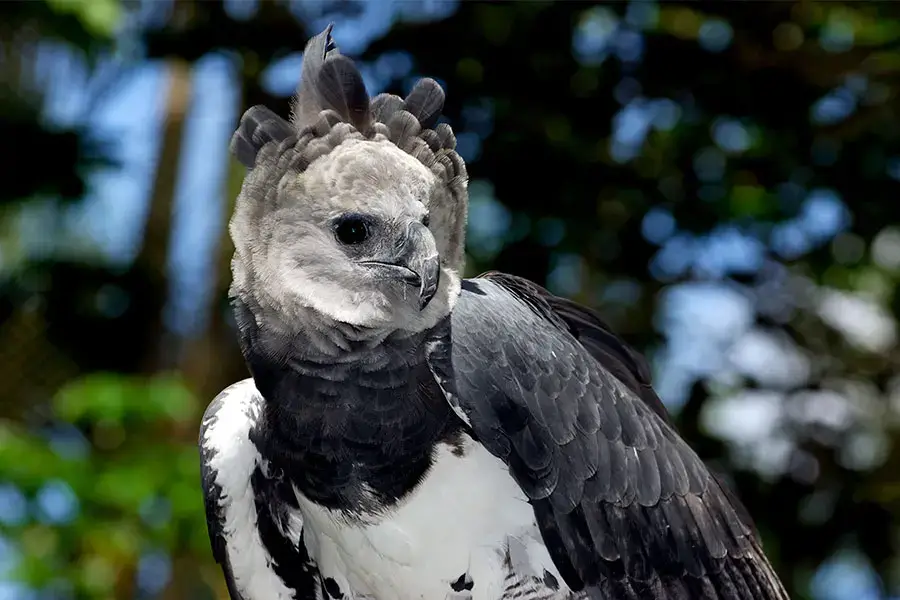Harpy Eagle: The Majestic Apex Predator of the Skies
The harpy eagle (Harpia harpyja) is one of the largest and most powerful predatory birds in the world. Known for its formidable talons, striking appearance, and keen hunting abilities, this bird of prey commands awe and fascination. With its fierce expression and regal presence, the harpy eagle has captured the imagination of cultures and nature enthusiasts alike.
In this article, we will explore the various aspects of this extraordinary species, from its scientific classification to its role in the ecosystem, as well as its complex relationship with humans.
Contents
Scientific Classification
- Kingdom: Animalia
- Phylum: Chordata
- Class: Aves
- Order: Accipitriformes
- Family: Accipitridae
- Genus: Harpia
- Species: H. harpyja
The harpy eagle belongs to the Accipitridae family, which includes hawks, kites, and other eagles. It is the only member of its genus, Harpia, and its name derives from the harpies of Greek mythology, which were fearsome winged creatures.
Physical Characteristics

- Size: Harpy eagles can grow up to 86–107 cm (34–42 inches) in length, with a wingspan ranging from 176 to 224 cm (5.8–7.4 feet).
- Weight: Females, being larger than males, weigh between 6 to 10 kg (13 to 22 lbs), while males weigh between 4 to 8 kg (8.8 to 17.6 lbs).
- Plumage: The harpy eagle’s plumage is primarily dark gray with a white underbelly and black-striped legs. It has a distinctive crest of long, black feathers that it raises when agitated or during displays.
- Talons: Harpy eagles have incredibly strong paws, with claws reaching lengths of up to 13 cm (5 inches), making them some of the largest talons in the avian world.
- Beak: Their curved, razor-sharp beak allows them to tear through tough prey with ease.
Habitat and Range
Harpy eagles are native to the tropical rainforests of Central and South America. Their range extends from southern Mexico down through Central America and into northern Argentina and Brazil. They thrive in lowland rainforests, typically inhabiting areas with large expanses of untouched forest, where they can find suitable prey and nesting sites.
- Preferred Habitat: Harpy eagles require dense forest canopies, which provide ample hunting grounds and protection.
- Elevation: They are usually found at elevations up to 2,000 meters (6,600 feet), though they are more commonly seen in lowland regions.
Behavior and Hunting
The harpy eagle is an apex predator, using stealth, strength, and agility to capture its prey. It is known for its patient hunting techniques, often perching silently for long periods before swooping down on unsuspecting animals.
- Hunting Style: Harpy eagles primarily hunt in the forest canopy, ambushing prey from above. With their powerful nails, they can capture large mammals and birds with ease.
- Prey: Their diet mainly consists of medium-sized arboreal mammals, such as sloths, monkeys, and opossums. They also hunt large birds like macaws and curassows.
- Flight: Despite their size, harpy eagles are incredibly agile in flight, allowing them to navigate through dense forests with ease.
Diet
Harpy eagles are carnivorous, specializing in hunting mammals that dwell in the trees.
- Primary Diet: Sloths, monkeys, and opossums form a significant part of their diet.
- Secondary Diet: They may also prey on reptiles like iguanas and large birds, including toucans and macaws.
Their strong paws allow them to catch and carry prey that often weighs nearly as much as they do.
Reproduction and Life Cycle
Harpy eagles are monogamous and form long-term pair bonds, often mating for life. They have a slow reproductive rate, producing a single offspring every two to three years.
- Nesting: They build large nests high in the treetops, often in emergent trees like kapoks. These nests can be up to 1.2 meters (4 feet) in diameter.
- Eggs: A female lays one or two eggs, but only one chick is typically raised, as the second egg acts as a backup in case the first egg or chick does not survive.
- Parental Care: Both parents share responsibilities in feeding and guarding the chick. The young eagle fledges after about six months but remains dependent on its parents for up to a year.
Predators and Threats
Adult harpy eagles have few natural predators due to their size and strength. However, chicks and eggs may be vulnerable to other birds of prey or opportunistic predators like snakes. The greatest threat to harpy eagles comes from human activity.
- Habitat Loss: Deforestation poses the most significant threat to harpy eagles. As large expanses of rainforest are cleared for agriculture and urban development, their hunting and nesting grounds are shrinking.
- Hunting: In some regions, harpy eagles are hunted by humans, either for their feathers or out of fear that they pose a threat to livestock.
Conservation Status
The International Union for Conservation of Nature (IUCN) classifies the harpy eagle as Near Threatened due to habitat loss and fragmentation. While conservation efforts are in place to protect the species, continued deforestation in the Amazon and other rainforests poses a severe threat to their survival.
- Conservation Programs: Various organizations are working to preserve the harpy eagle’s habitat and educate local communities about the importance of protecting this species. Conservationists are also using satellite tracking to monitor eagle populations in the wild.
- Captive Breeding: Zoos and breeding centers around the world have initiated captive breeding programs to increase the population of harpy eagles, with the ultimate goal of reintroducing them into their natural habitats.
Interesting Facts About Harpy Eagles
- The Largest Talons: Harpy eagles possess the largest talons of any living eagle species, which they use to snatch prey weighing up to 7 kg (15 lbs).
- Symbol of Power: The harpy eagle is a national bird of Panama, symbolizing strength and determination.
- Mythological Name: Named after the harpies of Greek mythology, these birds were said to be spirits of the wind.
- Superb Vision: Harpy eagles have exceptional eyesight, allowing them to spot prey from great distances, even through thick foliage.
Evolutionary History
The harpy eagle belongs to an ancient lineage of eagles that have evolved to become the dominant predators in their ecosystems. Fossil records suggest that their ancestors existed millions of years ago, honing their hunting techniques and physical characteristics to adapt to life in the dense rainforests of Central and South America.
Relationship with Humans
Harpy eagles have been revered by indigenous cultures for centuries, often considered spiritual creatures or symbols of power. Unfortunately, in modern times, their relationship with humans has been less harmonious. Deforestation, hunting, and urban expansion have drastically reduced their populations.
Conclusion
The harpy eagle is a fascinating and awe-inspiring species, representing the pinnacle of aerial predators. With its striking appearance, incredible strength, and vital role in the ecosystem, the harpy eagle deserves our admiration and protection. While it faces numerous challenges due to human activities, ongoing conservation efforts provide hope that this magnificent bird will continue to soar through the rainforests for generations to come.
- Golden Retriever Pros and Cons: What Every Pet Parent Should Know - 15 September 2025
- Cane Corso Dog Breed: Health, Care, and Lifespan - 14 September 2025
- Catahoula Leopard Dogs: Description, Temperament, Lifespan, & Facts - 21 July 2025







